winter tires AUDI S4 2017 Owners Manual
[x] Cancel search | Manufacturer: AUDI, Model Year: 2017, Model line: S4, Model: AUDI S4 2017Pages: 386, PDF Size: 96.32 MB
Page 76 of 386

Driving
next traffic light is red . This produces an engine
braking effect, which helps to protect the brakes
and tires and reduces the emissions and fue l con
sumpt ion to zero (fuel shut-off during decelera
t ion).
Shift effici ently
An effective way to save fuel is to upshift earlier.
Staying in a gear too long uses fue l unnecessari
ly .
P ress down o n the acce lerator peda l slowly and
avoid "kick -down".
Avoid full acceleration
You shou ld rare ly t rave l at the maximum vehicle
speed. High speeds cause a disp roportiona tely
h igh inc rease in fuel consump tion, emissions and
traffic no ise . Slower driving saves fuel.
Reduce idling time
The Start/Stop system* he lps to reduce the idling
time automatically. In vehicles witho ut the Start/
S top system* , it is efficient to swit ch the eng ine
off when stopped at r,;1ilro,;1d crossi ngs and long
red lights . Stopping the engine for 30 -40 sec
onds already saves more fuel than the amount of
extra fuel needed to restart the engine.
It t akes a very long time in idle to war m the en
g ine up to opera ting tempera ture . Wea r and
emissions are especially high in the warm -up
p hase . Therefore, yo u should begin driving im
mediately after starting the engine. Avoid high
RPMs while do ing th is.
Have maintenance performed regularly
By having ma intenance performed regularly on
your vehicle, you can help to reduce f uel con
sumpt ion befo re yo u even start to dr ive. The
maintenance condition of your vehicle not only
affects t raffic safety and long-term value but a l
so impacts
fuel consumpt ion . A poorly main
tained engine can lead to f uel consumption that
is 10% higher than normal.
Avoid short trips
The engine and exhaust cleaning system m ust
reach the ir opt imal
operating temperature to ef
fectively reduce consumption and em iss ions.
74
A cold engine uses a d isproportionately high
amount of fue l. The engine reaches operating
temperat ure and cons umption norma lizes on ly
after approximate ly
four ki lometers.
Check the tire pres sure
To save fue l, make sure the t ires are always in
flated to the correct press ure
¢ page 32 7. The
fuel consumpt ion can increase by S% if the pres
s u re is only 0.5 bar too low. Due to the increased
roll ing resistance, low tire pressures w ill also
l ead to greater tire
wear and will affect dr iving
behavior.
Do not drive on
winter tires year-round, as this
will consume up to 10% more f uel.
Eliminate unnecessary we ight
Since eve ry kil og ram o f extra weight in creases
fuel consumption, a quick inspection of the lug
gage compartment may be worth it to avoid un
necessary we ight.
When no t be ing used, a roof rack sho uld be re
moved to decrease the wind resistance of the ve
hicle . You will save approx imately
12% of your
fuel when at speeds from 62-75 mph (100-120 km/h).
Save energy
The eng ine drives the generator, which generates
electricity; the fuel consumption also inc reases
with the demand for e lectricity. Therefore, switch
e lectrical equ ipment off when you no longer
need it. Examples of eq uipment that uses a lot of
energy are air blowers at a high setting, the rear
window defogger and seat heating* .
(D Note
Do not leave engine idling unattended after
starting . If warning lights shou ld come on to
i ndica te improper operation, they would go
unheeded . Extended idling also prod uces
h eat, w hic h could result i n overheating o r
o ther damage to the veh icle o r othe r prope r
ty .
Page 139 of 386

<( a, .... N ..... N .... 0 0
3 a,
the engine braking effect and relieves the brakes.
If you need to brake additionally,
brake in interva ls and not continuously .
(D Tips
-If the brake booste r is no t working, you
must p ress the brake pedal with much more
fo rce than norma l.
- If you retrofit you r vehicle with a front spoil
er, whee l covers or s imilar items, make sure
that the air flow to the front whee ls is not
i nterr upted. Otherw ise the brake system
can become too hot .
Electromechanical power
steering, dynamic
steering
The electrom echanical steering supports th e
driver's steering movements.
P ower steering adapts electronically based on
the vehicle speed.
Indicator lights and messages
• Steering : malfunction! Plea se stop vehicle
If th is ind icator lig ht turns on and stays on and
this message appears, the power steer ing may
h ave fa iled.
Stop the vehicle in a safe locat io n as soon as pos
sib le . Do
not continue dr iving . See an a uthor ized
Aud i deale r or autho rized Aud i Serv ice Faci lity fo r
assistance .
':r-ij Steering: malfunction! You may continue
driving
If the indicator lig ht t urns on and the message
appears, the steering w heel may be mo re diffi
cult to move or more sensitive than usual. The
steer ing whee l may also be at an angle when
d riving s tra ight.
Drive s low ly to an author iz ed Audi dealer or au
thor ized Audi Service Facility to have the ma l
f u nction corrected .
~ Dynamic steering: correcting steering wheel
position
Intellig ent Technology
If the indicator ligh t turns on and this message
appears, the dynamic steering* is re init ializing.
The steeri ng whee l will be easy to move after
start ing the engine. Reinitiali zation might be
necessary if the steering wheel was moved whi le
the engine was sw itched off . The disp lay turns
off if the initializat ion was successf ul.
(D Tips
- If the . or ':r-ij indicato r light only stays on
for a sho rt time, you may cont inue drivi ng.
- The dynamic steering stability systems
c:.> page 134 are not ava ilable in the event of
a system malfunc tion.
- Fo r add itiona l information on dynamic
steeri ng, refer to
c:.> page 121.
ALL wheel drive (quattro)
App lies to : vehicles wit h all w heel drive
In all wheel drive, all four wheels are pow ered.
General information
In all wheel dr ive, the dr iving power is divi ded be
tween all four wheels . T h is happens aut omatical
ly depending on your dr iv ing behav ior as we ll as
the cur rent road condit ions . A lso refer to
c:.> page 134 , Electronic Stabilization Control
(ESC) .
A center d ifferential d istributes the driving powe r
var iably to the front and rea r axle .
It works to
ge ther w it h selec tive whee l to rque contro l, w hich
activates when driving thro ugh curves
c:.> page 134.
The all wheel dr ive concept is des igned for high
engi ne power . Yo ur vehicle is exce ptionally pow
erfu l and has excell ent driv ing cha rac teristics
bot h unde r normal d riving conditions and o n
sn ow and ice. A lways rea d and follow s afety pre
ca utions
c:.> &. .
Winter tires
By using all wheel dr ive, your ve hicle has good
forward mot ion w it h standard ti res in win ter con
di tions. However, i n w in te r, we re co m men d using
winter or all sea so n t ires on
all four whee ls, be-
c au se this will improve the
braking effec t. ..,.
137
Page 319 of 386

Wheels
Wheels and tires
General information
.,.Check your tires regularly for
damage (punctures, cuts, cracks
and bulges). Remove foreign ob
jects from the tire tread.
.,. If driving over curbs or similar
obstacles, drive slowly and ap
proach the curb at an angle.
.,.Have faulty tires or rims re
placed immediately.
"'Protect your tires from oil,
grease and fue l.
.,.M ark tires before removing
them so that the same running
direction can be maintained if
they are reinstalled.
"'Lay tires flat when storing and
store them in a cool, dry location
with as little exposure to light as
possible.
(D Note
-Please note that summer and
winter tires are designed for
the conditions that are typical in those seasons. Audi recom
mends using winter tires dur
ing the winter months. Low
temperatures significantly de crease the elasticity of summ
er tires, which affects traction
Wheels
and braking ability. If summer
tires are used in very cold
temperatures, cracks can form
on the tread bars, resulting in
permanent tire damage that
can cause loud driving noise
and unbalanced tires.
-Burn ished, polished or
chromed rims must not be
used in winter driving condi
tions. The surface of the rims
does not have sufficient corro
sion protection for this and
could be permanently dam aged by road salt or similar
substances.
Tire designations
Fig. 253 T ir e designations on the side -
wall Ill>
317
Page 321 of 386
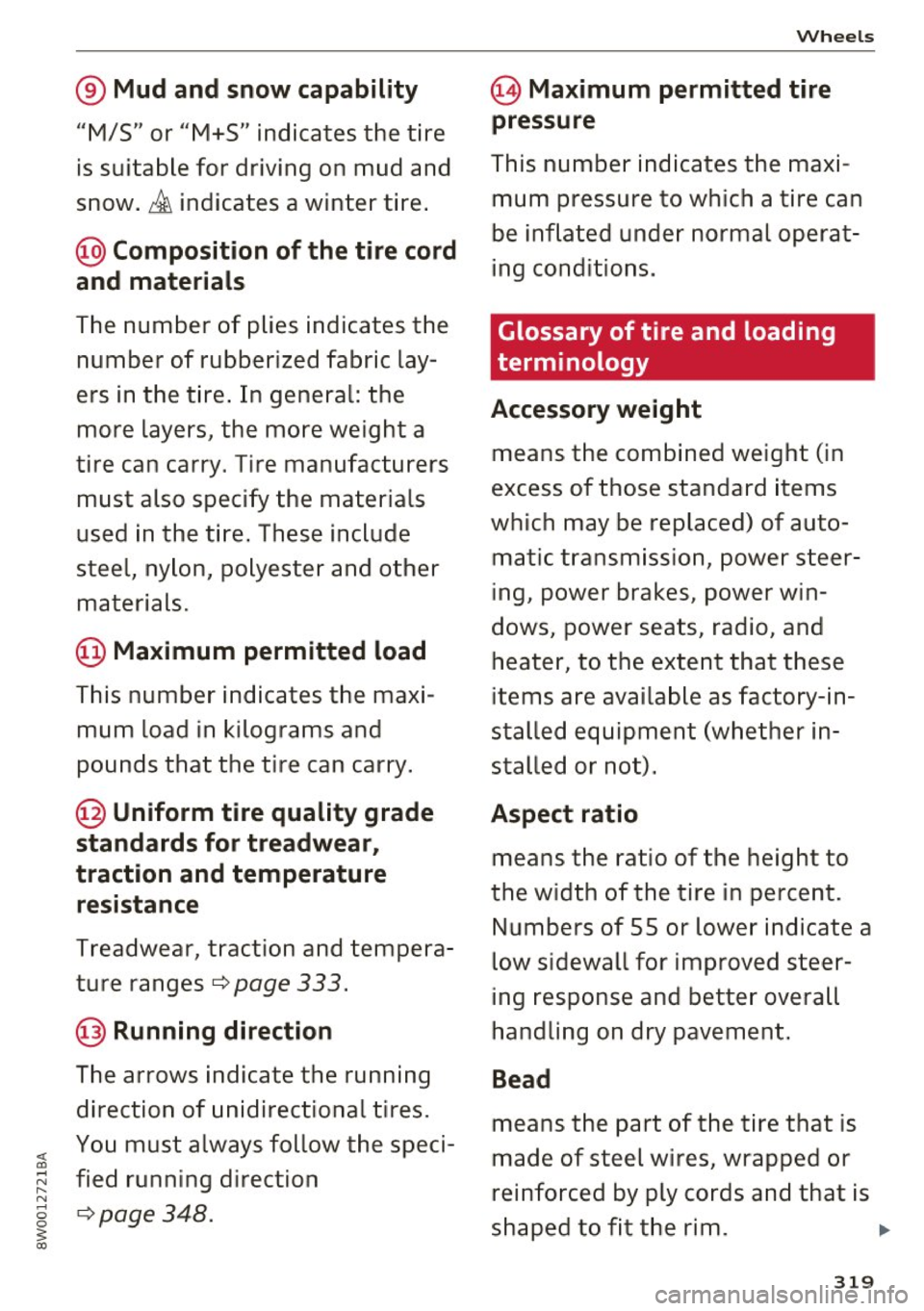
® Mud and snow capability
"M/5" or "M+S" indicates the tire
is suitable for driving on mud and
snow. £ indicates a winter tire.
@ Composition of the tire cord
and materials
The number of plies indicates the
number of rubberized fabric lay
ers in the tire . In general: the
more layers, the more weight a
tire can carry. Tire manufacturers must also specify the materials
used in the ti re . These inc lude
stee l, nylon, polyester and other
materials.
@ Maximum permitted load
This number indicates the maxi
mum load in kilograms and
pounds that the tire can carry.
@ Un iform tire quality grade
standards for treadwear,
traction and temperature resistance
Treadwear, traction and tempera
ture ranges
¢page 333.
@ Running direction
T he arrows indicate the running
direction of unidirectional tires.
You must always follow the speci
fied running direction
¢page 348.
Wheels
~ Maximum permitted tire
pressure
T his number indicates the maxi
mum pressure to which a tire can
be inflated under normal operat
ing conditions .
Glossary of tire and loading
terminology
Accessory weight
means the combined weight (in
excess of those standard items
which may be replaced) of auto matic t ransmission, power steer
ing, power brakes, power win
dows , powe r seats, radio, and
heater, to the extent tha t these
items are avai lab le as factory- in
stalled equipment (whether in
s t alled or not).
Aspect ratio
means the ratio of the height to
the w idth of the tire in percent.
Numbers of 55 or lower indicate a
low sidewall for improved steer
ing response and better overall
handling on dry pavement .
Bead
means the part of the tire that is
made of steel wires, wrapped or
reinfo rced by ply cords and that is
shaped to fit the rim. ...
319
Page 324 of 386
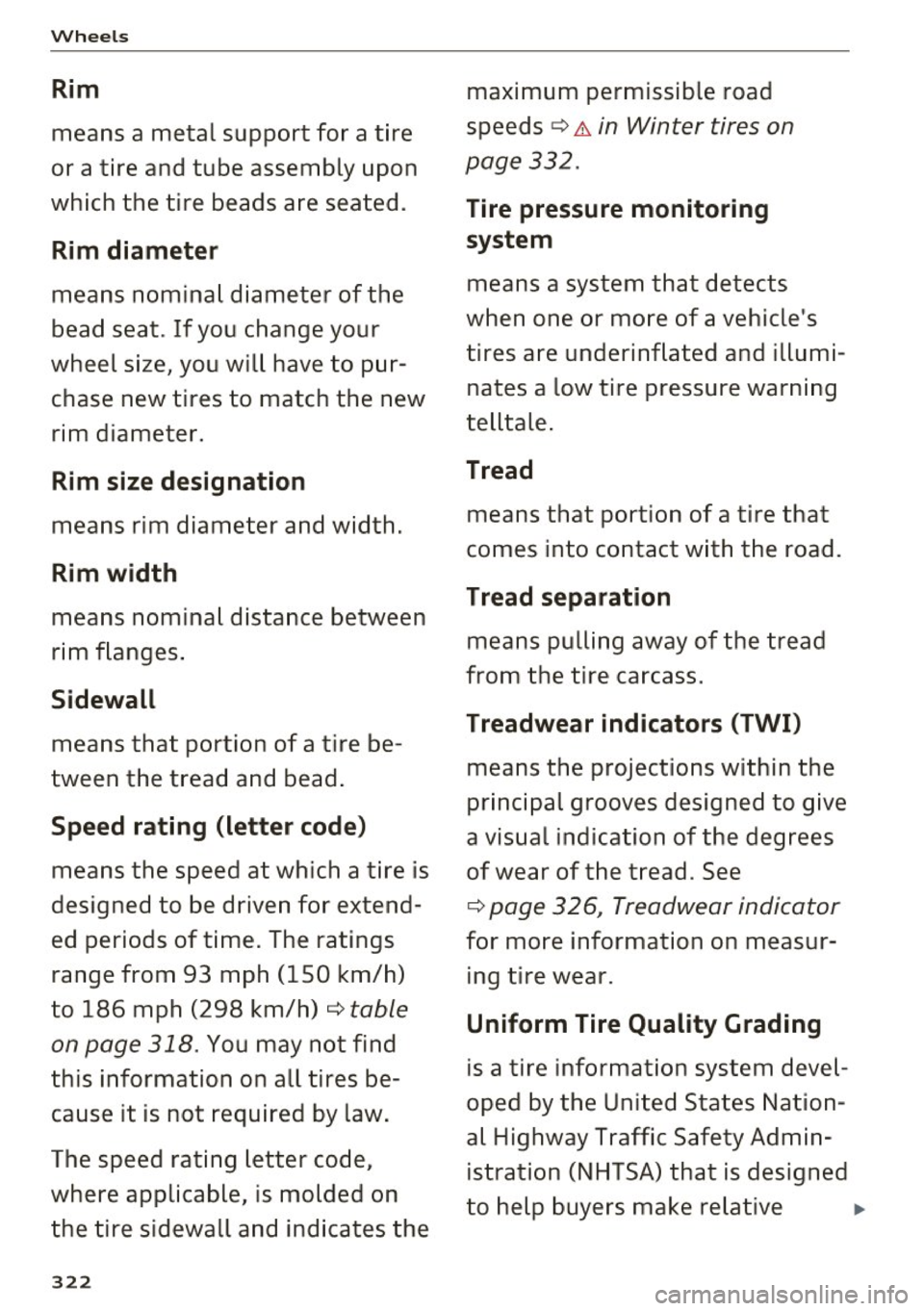
Wheels
Rim
means a metal support for a tire
or a tire and tube assembly upon
which the t ire beads are seated .
Rim diameter
means nominal diameter of the
bead seat . If you change your
wh eel size, you will have to p ur
chase new tires to match the new
rim d iameter .
Rim size designation
means rim diameter and w idth.
Rim width
means nomina l distance between
r im flanges .
Sidewall
means that portion of a t ire be
twee n the tread and bead .
Speed rating (letter code)
means the speed at which a t ire is
designed to be driven for extend
ed periods of ti me. The ratings
range from 93 mph (150 km/h)
to 186 mph (298 km/h)
¢ table
on page 318 .
You may not find
this information on all tires be
cause it is not required by law.
The speed rating letter code,
wh ere applicable, is molded on
the tire sidewall and ind icates the
322
maximum permissible road
speeds
¢ A in Winter tires on
page 332 .
Tire pressure monitoring
system
means a system that detects
when one or mo re of a vehicle 's
tires a re underinflated and illumi
nates a low tire pressure war ning
telltale .
Tread
means that portion of a tire tha t
comes into contact wi th the road.
Tread separation
means pulling away of the tread
from the tire carcass .
Treadwear indicators (TWI)
means the projections wi thin the
pr inc ipal grooves designed to g ive
a visua l indication of the degrees
of wear of the t read . See
¢ page 326, Treadwear indicator
for mo re information on meas ur
ing tire wear.
Uniform Tire Quality Grading
is a tire informa tion system devel
oped by the Unite d States Nation
a l Highway Traffic Safety Admin
is tration (NHTSA) that is designed
to help buyers make re lat ive
..
Page 326 of 386
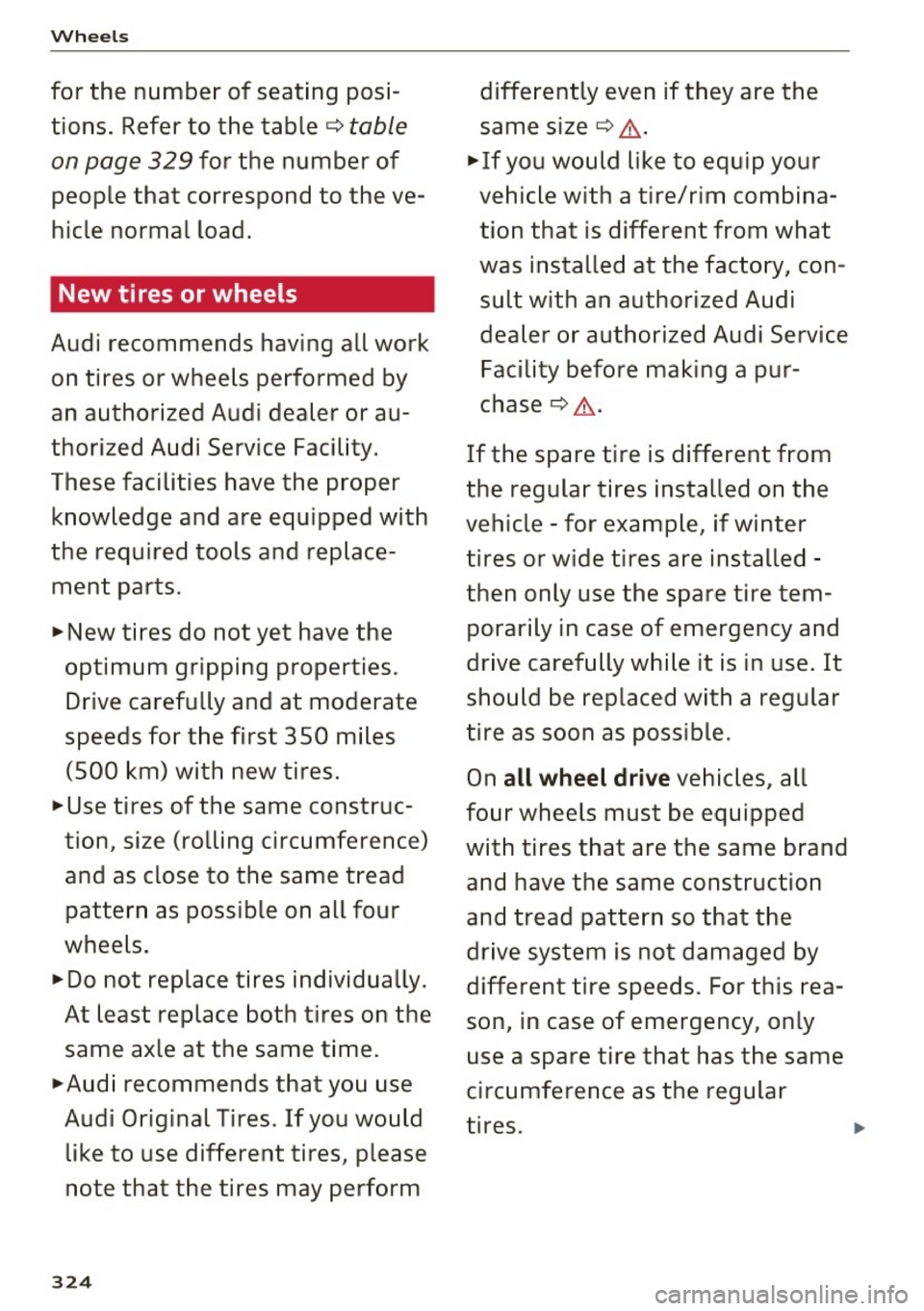
Wheels
for the number of seating positions. Refer to the table ¢
table
on page 329
for the number of
people that correspond to the ve
hicle normal load.
New tires or wheels
Audi recommends having all work on tires or wheels performed by
an authorized Audi dealer or au
thorized Audi Service Facility.
These facilities have the proper
knowledge and are equipped with
the required tools and replace ment parts.
.. New tires do not yet have the
optimum gripping properties.
Drive carefully and at moderate
speeds for the first 350 miles
(500 km) with new tires.
.. use tires of the same construc
tion, size (rolling circumference)
and as close to the same tread pattern as possible on all four
wheels.
11>D0 not replace tires individually.
At least replace both tires on the
same axle at the same time.
11>Audi recommends that you use
Audi Original Tires. If you would like to use different tires, please
note that the tires may perform
324
differently even if they are the
same size ¢
&.-
.,. If you would like to equip your
vehicle with a tire/rim combina
tion that is different from what
was installed at the factory, con
sult with an authorized Audi
dealer or authorized Audi Service Facility before making a pur
chase¢ &,.
If the spare tire is different from
the regular tires installed on the
vehicle - for example, if winter
tires or wide tires are installed -
then only use the spare tire tem porarily in case of emergency and
drive carefully while it is in use. It
should be replaced with a regular
tire as soon as possible .
On
all wheel drive vehicles , all
four wheels must be equipped
with tires that are the same brand
and have the same construction
and tread pattern so that the
drive system is not damaged by
different tire speeds . For this rea
son, in case of emergency, only
use a spare tire that has the same
circumference as the regular
tires . ""
Page 334 of 386

Wheels
bolts and a special procedure. You must never
repair or disassemble them ¢
.&..
A WARNING
Wheel bolts that are tightened or repaired in
correctly can become loose and result in loss
of vehicle control, which increases the risk of
an accident. For the correct t ightening specifi
cation, refer to ¢
page 348, Finishing .
-Always keep the wheel bolts and the
threads in the wheel hub clean and free of
grease .
- Only use wheel bolts that fit the rim .
- Always have damaged rims repaired by an
authorized Audi dealer or authorized Audi
Service Facility . Never repair or disassemble
rims yourself, because this increases the risk
of an accident.
Winter tires
W inter tires significantly improve the vehicle's
handling when driving in winter conditions. Be
cause of their construction (width, compound,
tread pattern) , summer tires provide less trac
tion on ice and snow.
.,. Use winter t ires on all four wheels.
.,. Only use winter tires that are approved for your
vehicle.
.,. Please note that the maximum permitted
speed may be lowe r with winter tires
q ,&. . An
authori zed Audi dealer or authori zed Audi Serv
ice Facility can inform you about the maximum
permitted speed for your tires .
.,. Check the tire pressure after installing wheels
¢page 327.
The effectiveness of winter tires is reduced great
ly when the tread is worn down to a depth of
0 .16 in (4 mm) . The characteristics of winter
tires also decrease great ly as the tire ages, re
gardless of the remaining tread .
A WARNING
-Never drive faster than the maximum per
mitted speed for your tires. This could cause
the tires to heat up too much. This increases
332
-
the risk of an accident because it can cause
the tire to burst.
- Always adapt your driving to the road and
traffic conditions . Drive carefully and reduce
your speed on icy or slippery roads . Even
winter tires can lose traction on black ice .
@ For the sake of the environment
Reinstall summer tires at the appropriate
time, because they prov ide better handling
when roads are free of snow and ice. Summer
tires cause less road noise, tire wear and fuel
consumpt ion .
(D Tips
You can also use all season tires instead of
winter tires. Please note that in some coun
tries where winter tires are required, only
winter tires w ith the ~ symbol are permitted .
Snow chains
Snow cha ins not only improve the driving in win
ter road condit ions, but also the braking.
.,. Only install snow chains on the
front wheels .
This applies a lso to vehicles with all wheel
drive* .
.,. Check and correct the seating of the snow
chains after driving a few feet, if necessary. Fol
low the instructions from the manufacturer.
.,. Note the maximum permitted speed when driv
ing with snow chains. Do not exceed 30 mph
(SO km/h) .
Use of snow chains is only permitted with certain
rim/tire combinations due to technical reasons.
Check with an authorized Audi deale r or author
ized Audi Service Facility to see if you may use
snow chains .
Use
fine-mesh snow chains. They must not add
more than 0.53 in (13 .5 mm) in height, including
the chain lock.
You must remove the snow chains on roads with
out snow. Otherwise , you could impair driving
ability and damage the tires .
Page 335 of 386
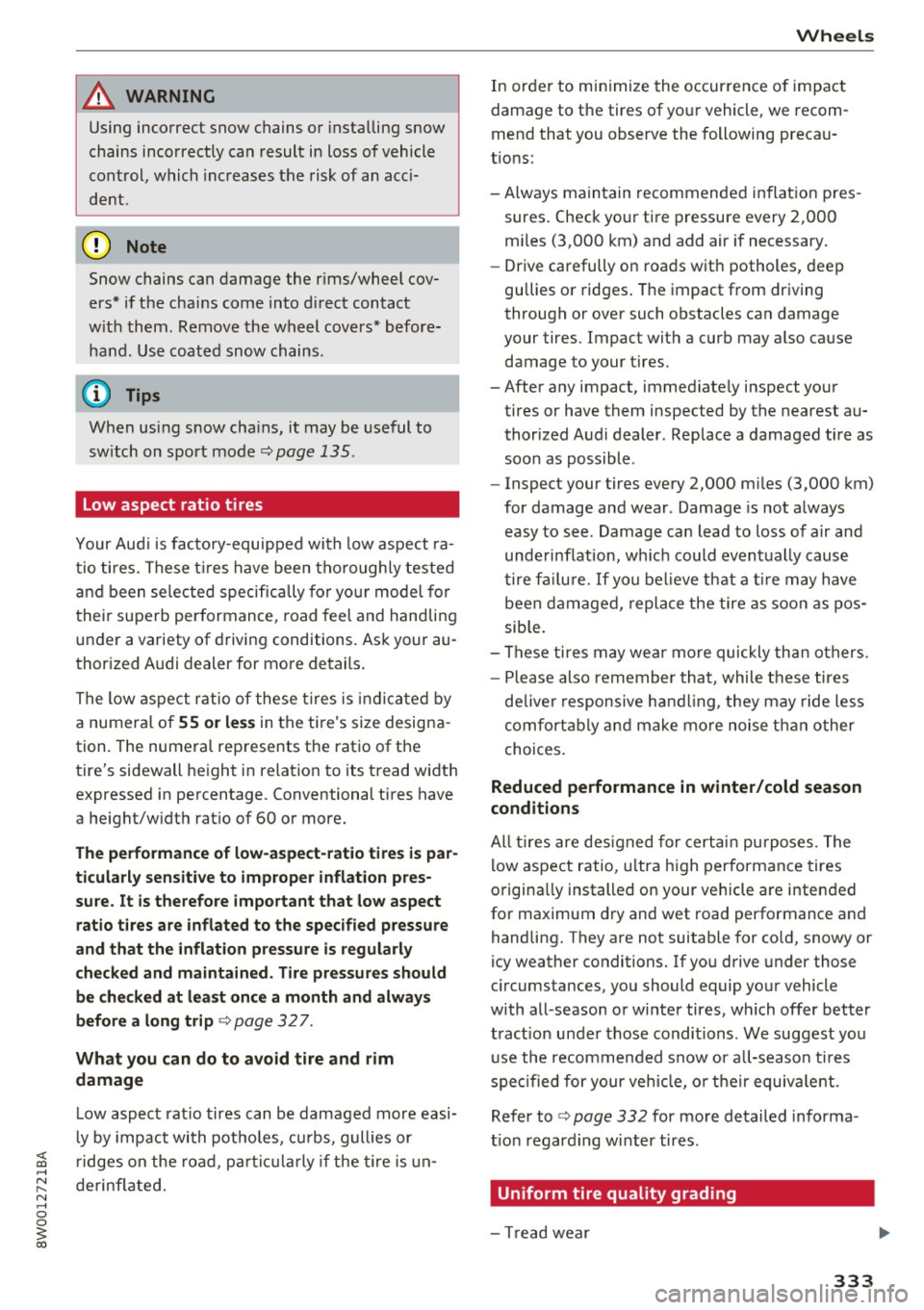
<( a, .... N ,....
N .... 0 0
3 a,
A WARNING ,~
Using incorrect snow chains or insta lling snow
chains incorrectly can result in loss of vehicle
control, which increases the risk of an acc i
dent.
(D Note
Snow chains can damage the r ims/wheel cov
ers* if the chains come into d irect contact
w ith them. Remove the wheel covers* before
hand . Use coated snow chains.
{1) Tips
When using snow cha ins, it may be useful to
sw itch on sport mode
¢page 135.
Low aspect ratio tires
Your Aud i is facto ry-equipped with low aspect ra
tio ti res. These t ires have been tho rough ly tested
and been se lected specifically for yo ur model for
their superb per formance, road feel and handling
under a variety of driving conditions. Ask your au
thorized Audi dealer for more details .
The low aspect ratio of these t ires is indica ted by
a numera l of
55 or les s in the tire's size designa
tion. The numeral represents the ratio of the
tire's sidewall height in r elation to its tread width
expressed in percentage. Conventional tires have
a height/w idth rat io of 60 or more.
The performan ce of low-aspect- ratio tire s is par
ticularl y sensiti ve to improper inf lat ion pres
sure . It is therefore impo rtant that low aspect
ratio tir e s are infl ated to the specified pressu re
and tha t the inflation pr essure is regularly
checked and maint ained . Tire pre ssure s should
be check ed at lea st once a month and alwa ys
b efore a long trip<=:>
page 32 7.
What you can do to a void tire and rim
damage
L ow aspect rat io tires can be damaged more easi
l y by impact with potho les, cu rbs, gull ies or
r idges on the road, pa rtic ularly if the tire is un
derinflated.
Wh eel s
In order to min imize the occurrence o f impact
damage to the tires of your vehicle, we recom
mend that you observe the following precau
t ions:
- Always maintain recommended inflation pres
sures . Check your tire pressure every 2,000
m iles (3,000 km) and add air if necessary .
- Drive carefully on roads with potholes, deep
gu llies or ridges . The impact from driving
through or over such obstacles can damage
your tires. Impact with a curb may a lso cause
damage to your tires.
- After any impact, immed iate ly inspect your
tires or have them inspected by the nearest au
thorized Audi dealer . Replace a damaged tire as
soon as possible .
- Inspect your tires every 2,000 m iles (3,000 km)
for damage and wear. Damage is not always
easy to see . Damage can lead to loss of a ir and
underinflation, wh ich could eventually cause
tire fa ilu re . If yo u bel ieve that a tire may have
been damaged, replace the tire as soon as pos
sible.
= These tires may wear mo re quickly tha n others.
- Please also remember that , while these tires
de live r responsive ha nd ling, they may ride less
comfort ably and make more noise t han other
choices .
Reduced performance in w inter /cold season
conditions
All tires are des igned for certai n pu rposes. The
low aspect ratio, ultra high performance tires
origina lly installed on your vehicle are intended
for maximum dry and wet road performance and handling. They are not suitable for co ld, snowy or
icy weather conditions. If you drive under those
c ircumstances, you should equip your vehicle
with all -season or winter tires, which offer better
tract ion under those conditions . We suggest you
use the recommended s now or a ll-season tires
spe cified for your vehicle, o r their equiva lent.
Refer
to <=:> page 332 for more detailed informa
t ion regard ing winter tires.
Uniform tire quality grad ing
- Tread wear
333
Page 338 of 386

Wheels
A WARNING
-If the tire pressure indicator appears in the
display, reduce your speed immediately and
avoid any hard steering or braking maneu
vers. Stop as soon as possible and check the
tires and their pressure .
- The driver is responsible for maintaining the
correct tire pressure. You must check the
tire pressure regularly.
- Under certain conditions (such as a sporty
driving style, winter conditions or unpaved
roads), the tire pressure monitoring system
indicator may be delayed.
@ Tips
- The tire pressure monitoring system can al
so stop working when there is an ESC mal
function.
- Using snow chains may result in a system
malfunction.
- The Tire Pressure Monitoring System in your
Audi was calibrated with "Audi Original
Tires "~
page 324. We recommend that you
use these tires.
Storing tire pressures
If the tire pressure changes or a tire is replaced,
it must be confirmed in the Infotainment sys
tem .
.. Before storing the tire pressures, make sure the
tire pressures of all four tires meet the speci
fied values and are adapted to the load
~page 327 .
.. Switch on the ignition .
.. Select in the Infotainment system:
IMENU I but
ton
> Vehicle > Service & checks> Tire pres
sure monitor> Store tire pressure > Yes, store
now.
(D Tips
Do not store the tire pressures if snow chains
are installed .
336
Page 352 of 386
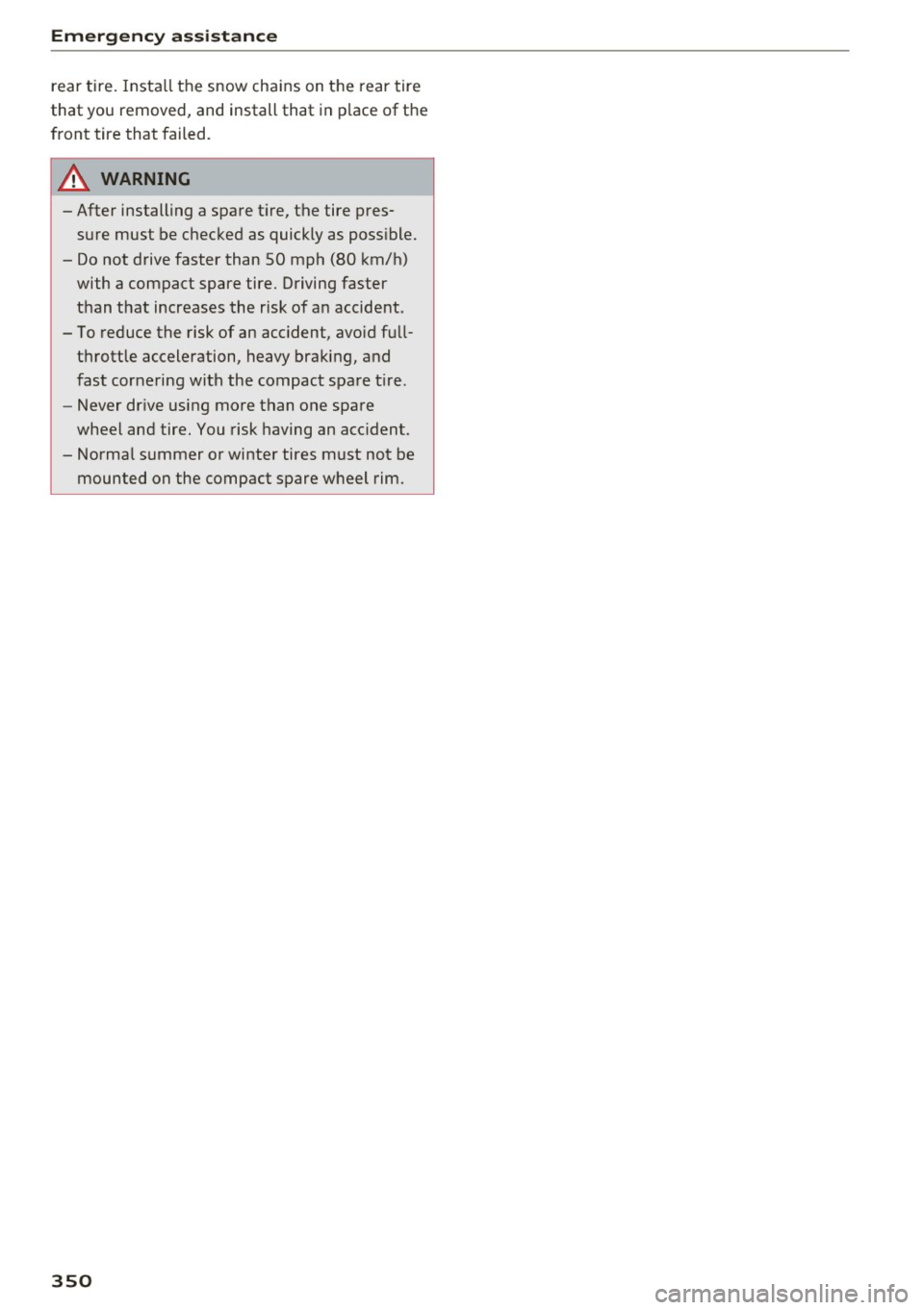
Emergency assistance
rear tire . Insta ll the snow cha ins on the rear tire
that you removed, and install that in p lace of the
f ront tire that failed.
A WARNING
- After installing a spare t ire, the tire p res
s u re must be chec ked as quickly as poss ible.
- Do not drive faster than 50 mph (80 km/h) with a compact spare tire. Driving faster
th an that increases the risk of an accident.
- T o reduce the risk of an accident, avo id f ull
throttle acceleration, heavy braking, and
fast cornering with the compact spa re t ire.
- Never dr ive using more than one spare
wheel and tire . You risk having an acc ident.
- Norma l summer or winter tires must not be
mounted on the compact spare wheel rim.
350
-